
Бесплатный фрагмент - What are flowers silent about?
Rose
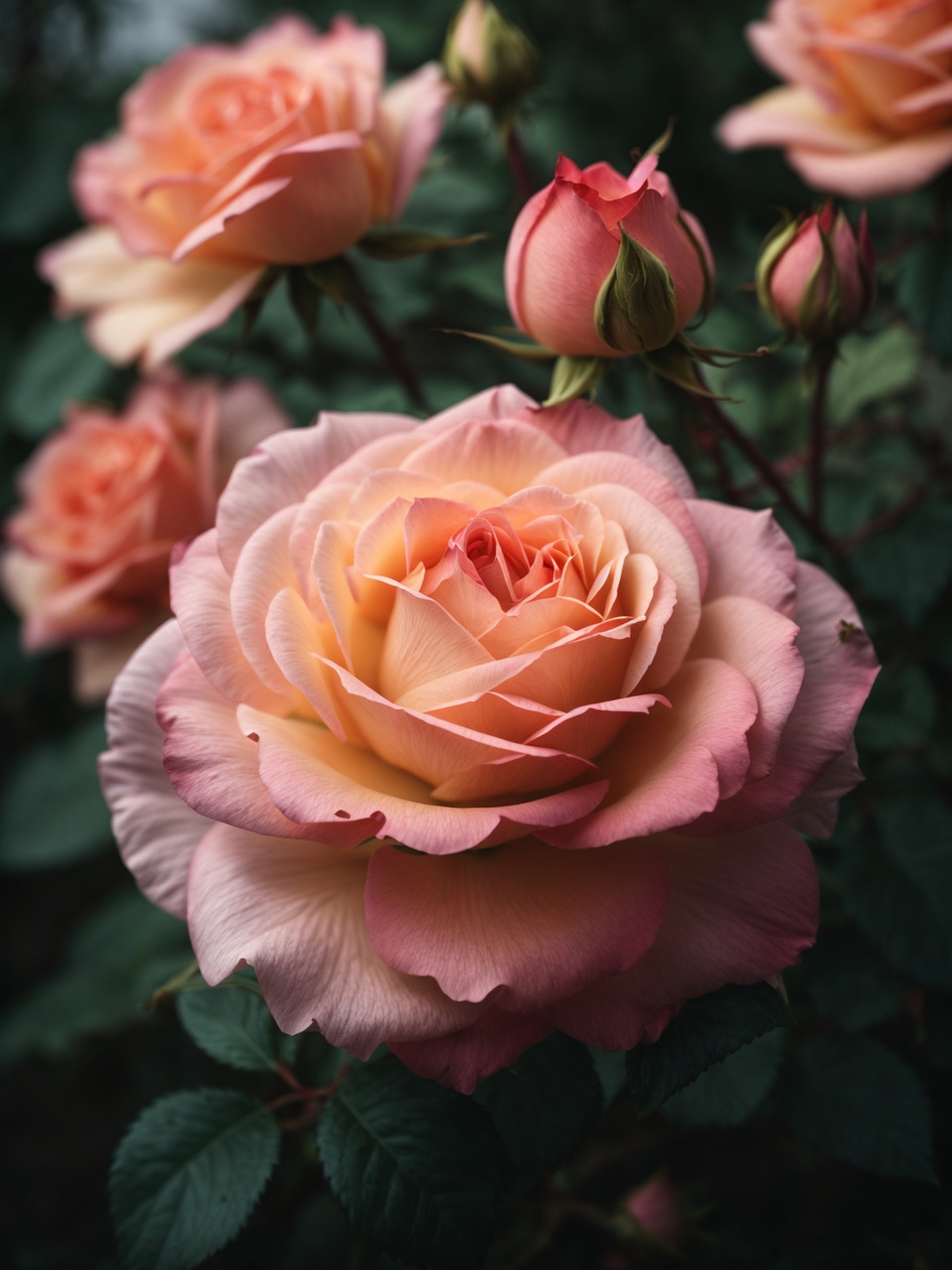
Adonis and Aphrodite
In Ancient Greek mythology, there is a beautiful legend associated with the creation of the rose. It revolves around Aphrodite, the goddess of love and beauty, and her beloved Adonis.

Adonis, known for his extraordinary handsomeness, was a mortal man who captured the heart of Aphrodite. The couple shared a passionate and intense love, but sadly, their story was not without tragedy. Adonis was a skilled hunter, and one day, while pursuing a wild boar, he was severely wounded by the creature’s tusks.
Aphrodite, upon hearing of Adonis’ perilous condition, rushed to his side, tears streaming down her face. As her tears mingled with the thick, red blood that poured from Adonis’ wounds, a beautiful transformation took place. Under the divine influence of Aphrodite’s love and sorrow, the droplets of blood and tears transformed into delicate petals, their hue reflecting the crimson of Adonis’ life force mixed with the pale, ethereal tears of the goddess.
From this harmonious fusion of divine lamentation and mortal blood, the first rose was born. Its petals, adorned with the vibrant reds of passion and the tender pinks of affection, showcased the eternal connection between love and beauty. The rose became a symbol of undying love, capturing the essence of Aphrodite’s devotion and the fragility of human existence.

Ever since that momentous event, the rose has served as a symbol of love, beauty, and passion. It is a reminder of the powerful emotions and profound connections that exist between mortal and divine beings. The legend of Aphrodite and Adonis, intertwined with the creation of the rose, continues to be told and celebrated, enchanting generations with its tale of love’s endurance and the eternal beauty encapsulated within a delicate flower.
Virgin Mary
In Christian tradition, there is a beautiful legend associated with the rose and its connection to the Virgin Mary, the mother of Jesus. According to this legend, when Mary, the pure and immaculate mother, passed away from this earthly life, she was laid to rest in a tomb.
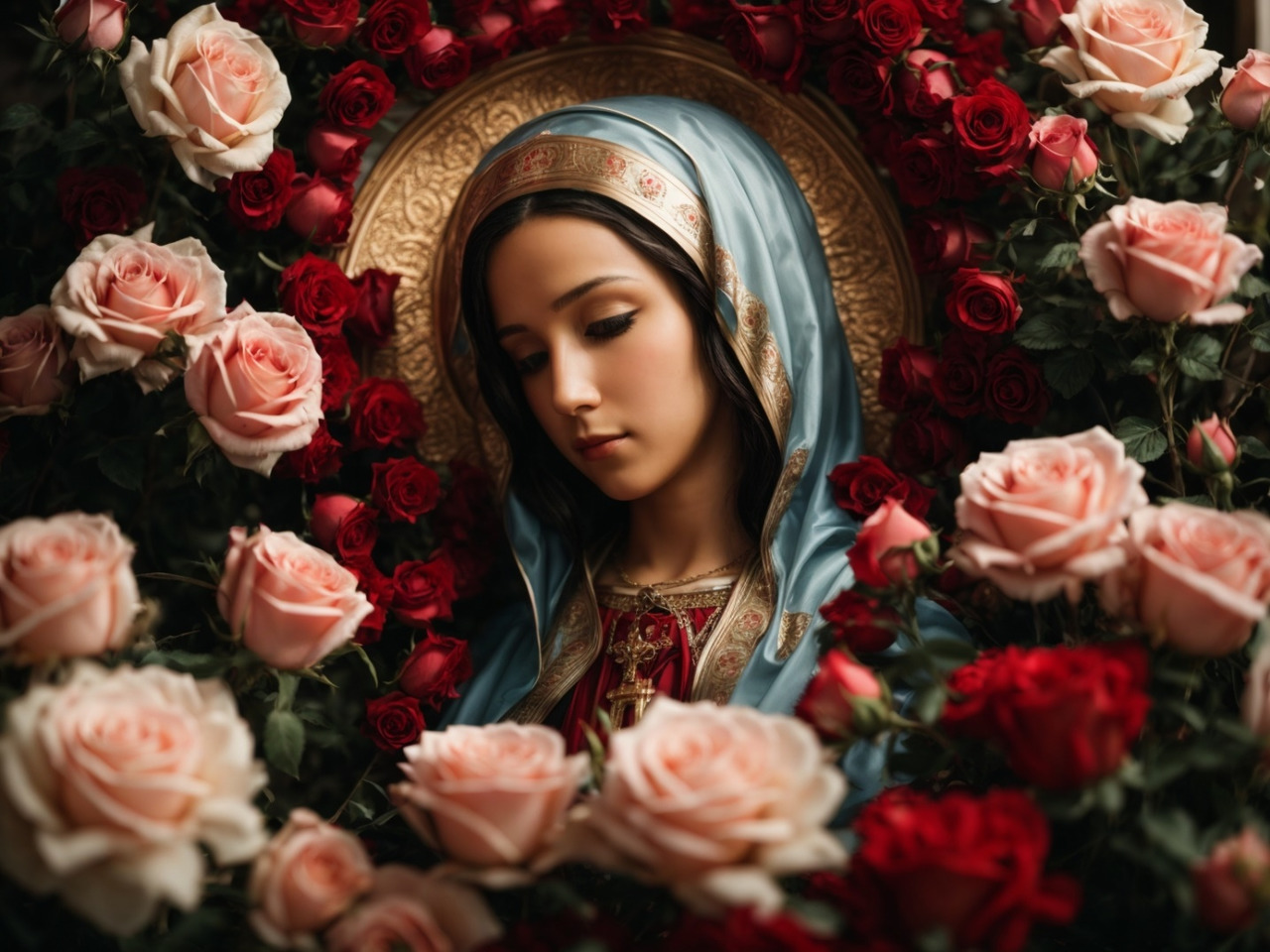
Many years later, when her tomb was opened, a miraculous sight awaited those who beheld it. Instead of finding the mortal remains, the tomb was filled with a divine fragrance and a wondrous sight: a profusion of magnificent roses, blooming in radiant hues and emanating heavenly beauty.
The appearance of these roses was seen as a sign of the Virgin Mary’s enduring purity and exalted state in the celestial realms. The roses symbolized her immaculate grace and served as a testament to her divine favor and intercession.

Inspired by this extraordinary event, the rose became closely associated with the Virgin Mary and her role in Christian devotion. The rosary, a prayer form dedicated to the Virgin Mary, took on the symbolism of the rose. The individual prayer beads of the rosary were likened to the delicate petals of the rose, and the recitation of each prayer represented the offering of a precious rose to the Blessed Mother.
In art and religious symbolism, the rose is often depicted as an attribute of Mary, adorning images and statues of her. It serves as a reminder of her purity, beauty, and maternal love, reflecting her special place as the Mother of God.
The legend of the roses found in Mary’s tomb highlights the significance of the Virgin Mary in Christian faith and underscores the enduring connection between the rose and her devotion. It stands as a testament to her grace and the eternal beauty and power of her intercession.
White rose and nightingale
In Persian literature, there exists a poignant and melancholic legend of the Nightingale and the Rose, which has captured the hearts of many through the works of celebrated poets like Hafez.
The tale begins with a nightingale, renowned for its enchanting songs and melodies, encountering a white rose of unparalleled beauty and fragrance. The nightingale, captivated by the rose’s elegance and irresistible charm, falls deeply in love with its ethereal presence.
Filled with a passionate longing for the rose, the nightingale expresses its love through melodic serenades, composing symphonies that resonate through the stillness of the night. With every sweet note, the nightingale pours forth its heart, declaring love and devotion to the unresponsive rose.
Yet, sadly, the rose remains oblivious to the nightingale’s passionate pursuit. Its petals, delicate and pristine, remain closed and unaffected, unaware of the nightingale’s fervent chorus. The nightingale’s love becomes increasingly fervent, and its heart aches for the rose’s attention.
Driven to despair by this unrequited love, the nightingale feels an overwhelming pain in its heart. In a desperate act of sacrifice born from a profound love that transcends mortal bounds, the nightingale impales itself upon a thorn of the rose, offering its lifeblood as a testament to its devotion.
As the nightingale’s life ebbs away, an extraordinary transformation takes place. From the fallen nightingale’s heart, crimson droplets of blood trickle onto the ground below. In that tragic moment, the earth absorbs these divine offerings and bestows upon it a wondrous gift: a crimson rose, born from the sacrificial love of the nightingale.

This crimson rose, arising from the essence of the nightingale’s adoration, is a powerful symbol of eternal love and the enduring spirit of sacrifice. It serves as a reminder of the profound and often painful sacrifices made for love, representing the bittersweet nature of longing and the fragility of mortal existence.
The Legend of the Nightingale and the Rose echoes through the melodies of Persian poetry, resonating with readers and listeners alike. It conveys the timeless themes of unrequited love, the depths of devotion, and the sacrifices made for cherished affections. Through the nightingale’s sacrifice, a crimson rose emerges, immortalizing the love that transcends beyond the boundaries of life itself.
Flora and Zephyrus
In Roman mythology, there is a captivating legend involving Flora, the goddess of flowers, and Zephyrus, the god of the west wind. The tale, beautifully narrated by the Roman poet Ovid, tells of a love story obscured by disguise and revealed through a fateful gust of wind.

Flora, known for her radiant beauty and affiliation with the abundance of springtime blossoms, found herself pursued by Zephyrus. The god of the west wind was captivated by Flora’s enchanting allure and persistent in his pursuit of her affection. However, Flora, desiring a respite from Zephyrus’ relentless advances, sought refuge by transforming herself into a delicate flower, concealing her true identity and eluding him.
Embracing her newfound form as a flower, Flora bloomed into an exquisite and wondrous blossom, her petals unfolding with an ethereal grace. As the gentle breezes caressed her petals, Zephyrus, driven by his longing to find Flora, pursued her even more fervently.
Undeterred by Flora’s transformation, Zephyrus summoned forth the winds to intensify his pursuit. The gusts grew powerful, swirling and enveloping the flower in a tempestuous embrace. With each gust, the force of Zephyrus’ wind blew away the delicate petals, meticulously unraveling the guise that Flora had adopted.
Finally, when Flora’s petals were stripped away, her true form was revealed. Zephyrus recognized her and was captivated by her radiance. In this moment of revelation, their love found its way, unencumbered by disguise or artifice. Flora and Zephyrus embraced, their union symbolizing the powerful connection between the blooming of flowers and the gentle caress of the wind.
The legend of Flora and Zephyrus serves as a testament to the transformative nature of love. It celebrates the unity of nature and beings, emphasizing the interplay between the floral realm and the invisible forces of nature. Through Flora’s disguise as a flower and Zephyrus’ unwavering pursuit, the legend reinforces the eternal dance of attraction and desire.
In Roman art and literature, this narrative of Flora and Zephyrus has woven its way into countless depictions and interpretations, captivating audiences with its symbolism and profound representation of love’s ability to transcend barriers.
Sufism

In Islamic literature, particularly in Sufi poetry, the rose takes on a deeper metaphorical meaning. Sufism is a mystical branch of Islam that seeks a direct personal experience of the divine. Sufi poets often employ symbolism and imagery to express their longing for the divine union and the transformative nature of the spiritual journey.
The rose is often used in Sufi poetry to represent the blossoming of the soul and the ecstatic experience of divine love. Just as the rose blooms and radiates its fragrance, the Sufi seeks to cultivate the inner self and attain spiritual enlightenment. The opening of the rose’s petals mirrors the opening of the lover’s heart to the divine attributes, awakening a passionate longing to be united with the Beloved.

The thorns of the rose, while symbolizing the challenges and trials of the path, also represent the necessary sacrifices one must make in the pursuit of spiritual growth. The Sufi poet seeks to navigate these thorns, enduring the pains of separation from the Divine Beloved, in the hope of attaining union and merging their own essence with that of the divine.
The rose’s vibrant colors, its fragrance, and its delicate yet resilient nature evoke the qualities of the spiritual seeker on the path of divine love. Through Sufi poetry, disciples are inspired to surrender themselves to the transformative power of love, allowing their hearts to bloom like a radiant rose in the garden of divine devotion.
Cupid and Psyche
In Roman mythology, the captivating tale of Cupid and Psyche unfolds as a testament to the power of love, perseverance, and the ultimate triumph over adversity.
Psyche, a mortal woman of unparalleled beauty, unwittingly caught the eye and heart of Cupid, the mischievous god of love. Cupid was smitten, and their love grew deep and fervent. However, their love was not without its challenges.

Psyche’s beauty caused great envy among mortals and even the goddess Venus herself. Consumed by jealousy, Venus devised a plan to separate Psyche from Cupid. She forbade Psyche from ever gazing upon Cupid’s face, making their love a clandestine affair. Cupid, bound by his mother’s command, visited Psyche only under the cover of darkness, ensuring that his true form remained hidden from her eyes.
However, curiosity and doubt began to take hold in Psyche’s heart. Night after night, she wondered about her lover’s true identity. One night, unable to resist the urge any longer, she lit a candle to behold Cupid’s face while he slept beside her.
As the candle’s light flickered, a drop of hot wax fell upon Cupid, awakening him from his slumber. Heartbroken and feeling betrayed, Cupid fled from Psyche’s presence, leaving her bereft and alone. Psyche, consumed by grief and longing for her lost love, resolved to win him back at any cost.
Psyche embarked on a perilous quest assigned by Venus herself. Each task was seemingly impossible, from collecting golden fleece guarded by vicious sheep to harvesting grain from a field of venomous serpents. With unwavering determination and the intervention of various gods and creatures, Psyche overcame each trial, proving her strength and dedication.
During her journey, Psyche encountered a darkness that threatened to engulf her spirit. In her despair, she considered ending her life. But it was then that nature herself, in a moment of divine intervention, comforted and guided her. Roses blossomed from the earth, emanating their gentle scent and reminding Psyche of the enduring nature of love.
The fragrant roses marked her path, filling the air with their sweet perfume and offering solace and hope. Encouraged by this sign, Psyche continued her quest with renewed resolve.
Finally, after completing her arduous trials, Psyche arrived at the realm of the gods. There, she was reunited with Cupid, who had never ceased to love her despite his initial anger. Their love, now stronger and more resilient than ever before, was celebrated by the gods and immortalized in the emblem of roses, symbolizing the endurance and sweetness of their love.

The legend of Cupid and Psyche serves as a reminder that love can withstand even the harshest trials. Psyche’s unwavering faith and perseverance allowed her to navigate the obstacles in her path and emerge triumphant. The roses that bloomed in her wake stand as a symbol of their enduring love, filling the world with their timeless beauty and imparting upon their story a sense of eternal romance.
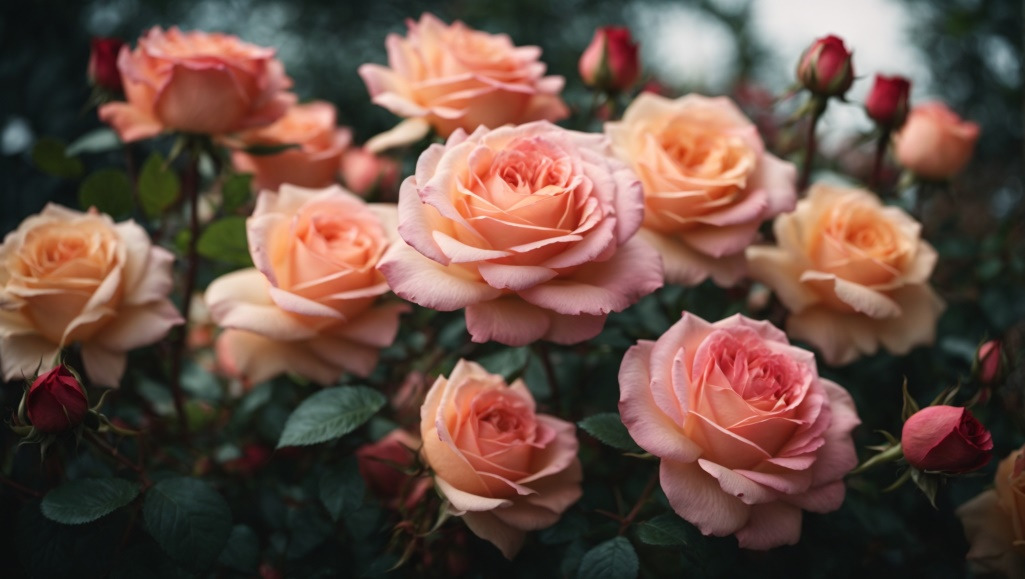
Orchid
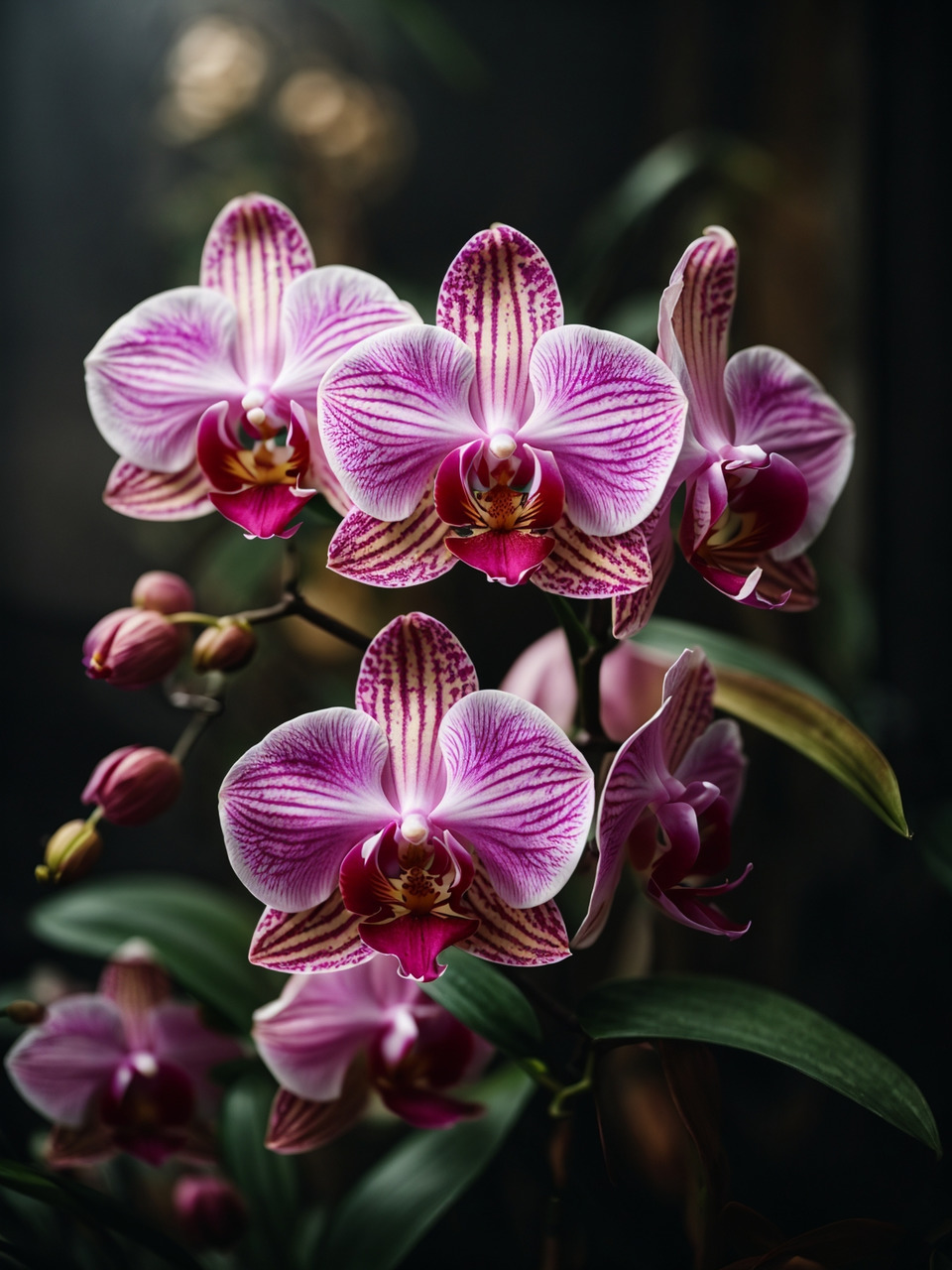
Amazon Goddess
In the lush lands of the Amazon, where nature thrives and legends come alive, there once resided a goddess of extraordinary beauty and kindness. She possessed a remarkable gift, for she could see only the inherent beauty in the world, unable to perceive rudeness or ugliness.

This goddess, whose name has been lost to time but whose essence remains vibrant in the lore of the Amazon Indians, dwelt in the country of four parts of the world, where the rivers flowed endlessly and the rainforest whispered ancient secrets. She radiated love and compassion, spreading her warmth to all creatures, be they large or small, humble or magnificent.
Yet, this goddess’s benevolent nature provoked jealousy and animosity among the other gods. Envious of her ability to perceive only the good in their realm, they deemed her too idealistic, deluded in her vision of the world. Filled with disdain, the gods passed judgment upon her, sentencing her to confinement until they could decide her fate and banish her from the land they ruled.
In the realm of the gods, an arts-loving deity, young and impassioned, caught sight of the captive goddess. His heart was instantly captured, and he fell deeply in love with her radiant spirit. Filled with determination and fueled by the intoxication of love, he hatched a daring plan to free the goddess from her imprisonment and escape the realm of the gods.
However, the gods, angered by the audacity of the young deity’s actions, vowed to put an end to their love. In their fury, they took the life of the young god, tearing him away from his beloved forever. The goddess, consumed by grief and unable to bear the thought of being separated from her lover, underwent a transformation born of immense love and profound sorrow.
With the last whispers of her devotion, the goddess metamorphosed into a breathtaking orchid flower, its delicate petals capturing the luminosity of her spirit and the purity of her love. The orchid, adorned with grace and eternal beauty, became a symbol of the goddess’s enduring presence and the indomitable power of love.
Today, in the magical depths of the Amazon rainforest, where life burgeons with remarkable diversity, the legend of the goddess and the young god lives on. Amidst the rich tapestry of flora and fauna, the enchanting orchid continues to bloom, a testament to the eternal bond between two souls and the everlasting beauty that can be found even in the darkest of times.
The Dance of the Forest Spirits

Long ago, when the world was filled with wonders and mystical beings, there was a mischievous band of forest spirits known as the Silvanitas. These ethereal creatures would frolic through the ancient woodlands, spreading joy and merriment wherever they went.
One day, as the Silvanitas danced beneath the moonlit sky, their playful footsteps caught the attention of the goddess of nature herself. Enchanted by their carefree revelry, she decided to reward their pure spirits with a gift. Through her divine touch, she transformed the tiny footsteps of the Silvanitas into delicate, enchanting flowers known as lady’s slipper orchids.
From that day forward, the lady’s slipper orchids became a testament to the lively dances of the Silvanitas. Each vibrant blossom symbolized the steps taken by these mischievous forest spirits, capturing their grace and playful energy for all eternity. To this day, when the moon shines its brightest, one can still witness the Silvanitas’ ethereal dance through the lady’s slipper orchids, reminding us of the everlasting magic that resides in the heart of the forest.
Healing Touch
Within the deep recesses of the forest, an ancient tale is whispered among the trees. It is said that once, in a time of great sorrow and hardship, a powerful healer roamed the land seeking to alleviate the suffering of the people.
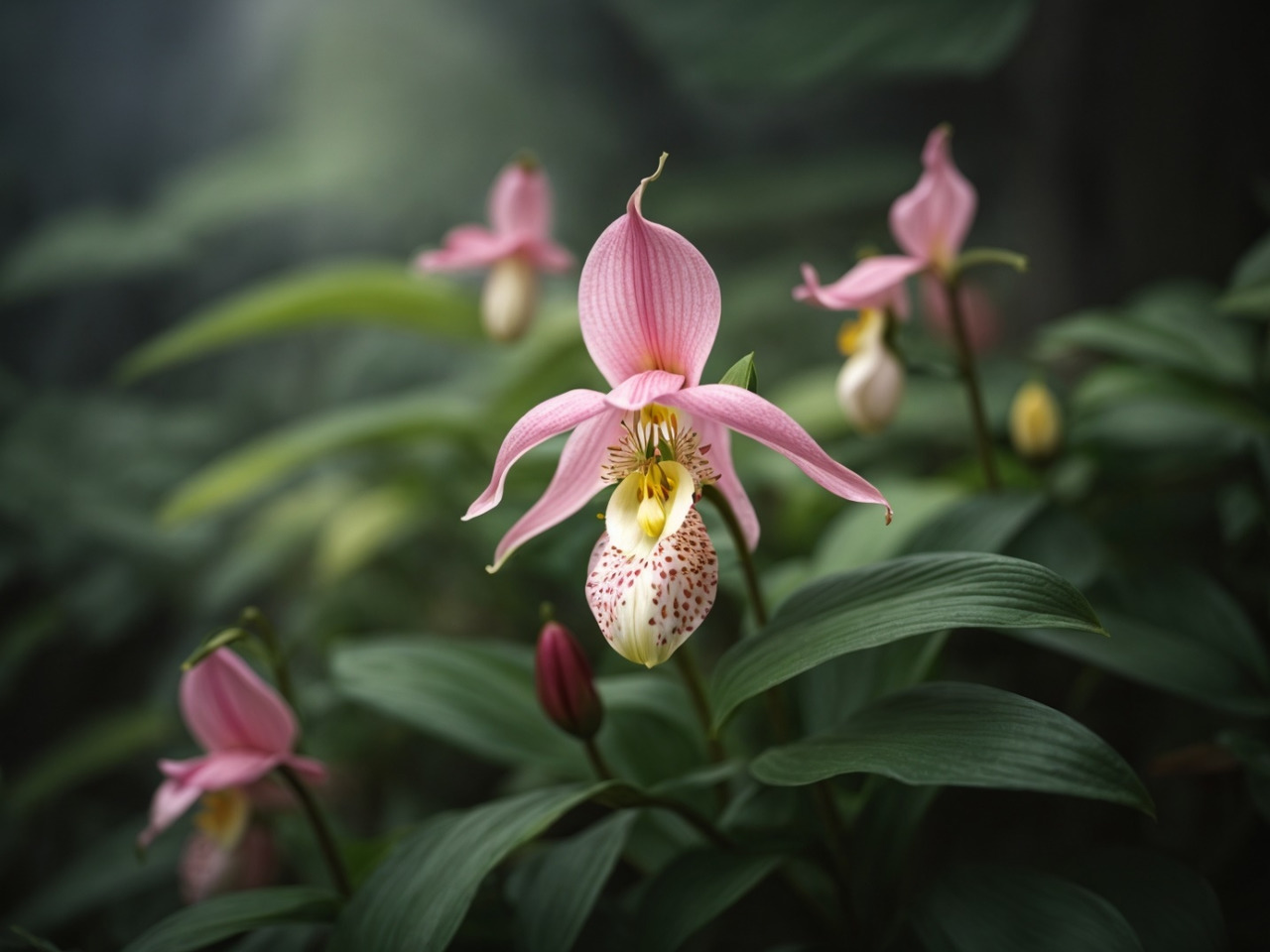
This healer possessed an innate connection to nature and possessed the gift of healing with her touch. Guided by her compassion, she would wander through the dense forest, listening to the pleas of the wounded and the desperate.
One fateful day, the healer encountered a group of lost and weary travelers who had succumbed to intense exhaustion. She could see their struggle and felt an overwhelming urge to help. In her hands, she held a small pouch filled with the seeds of the lady’s slipper orchids, known for their mystical healing properties.
Placing the delicate seeds on the ground, the healer uttered a fervent prayer to the forest spirits, asking for their guidance and blessings upon the seeds. As her prayer reached the heavens, it attracted the attention of the divine. The goddess of healing, moved by the healer’s selflessness, granted her request.
Miraculously, the seeds sprouted and bloomed into exquisite lady’s slipper orchids. Their vibrant colors and sweet fragrance filled the air, infusing the weary travelers with renewed strength and vitality. The healer and the people rejoiced, for they had witnessed the incredible healing power of the lady’s slipper orchid.
From that moment on, lady’s slipper orchids became revered as a symbol of healing and strength. Even today, in the depths of the forest, healers seek out these radiant blossoms, believing that their sacred touch can alleviate pain and restore balance to those in need.
Lgend of the Rainbow Orchids
Among the lush landscapes of New Zealand, there exists a tale that speaks of the creation of the magnificent orchids that grace the land. Long ago, in a time of darkness, the sky became shrouded in thick clouds, obscuring the radiant glow of the sun. The earth grew cold and dim, and the people yearned for the return of light and warmth.
Filled with determination, the sun sent forth its rays, piercing through the dense clouds in an attempt to disperse the gloom. But the clouds, obstinate and unyielding, resisted the sun’s efforts. Instead, they gathered their strength and released a deluge of rain upon the land.
As the rain cascaded from the heavens, a symphony of droplets fell upon the earth. Cleansing the air and regenerating the soil, this rain carried a spark of celestial magic within it. When the downpour ceased, a wondrous sight unfolded before the eyes of the people.
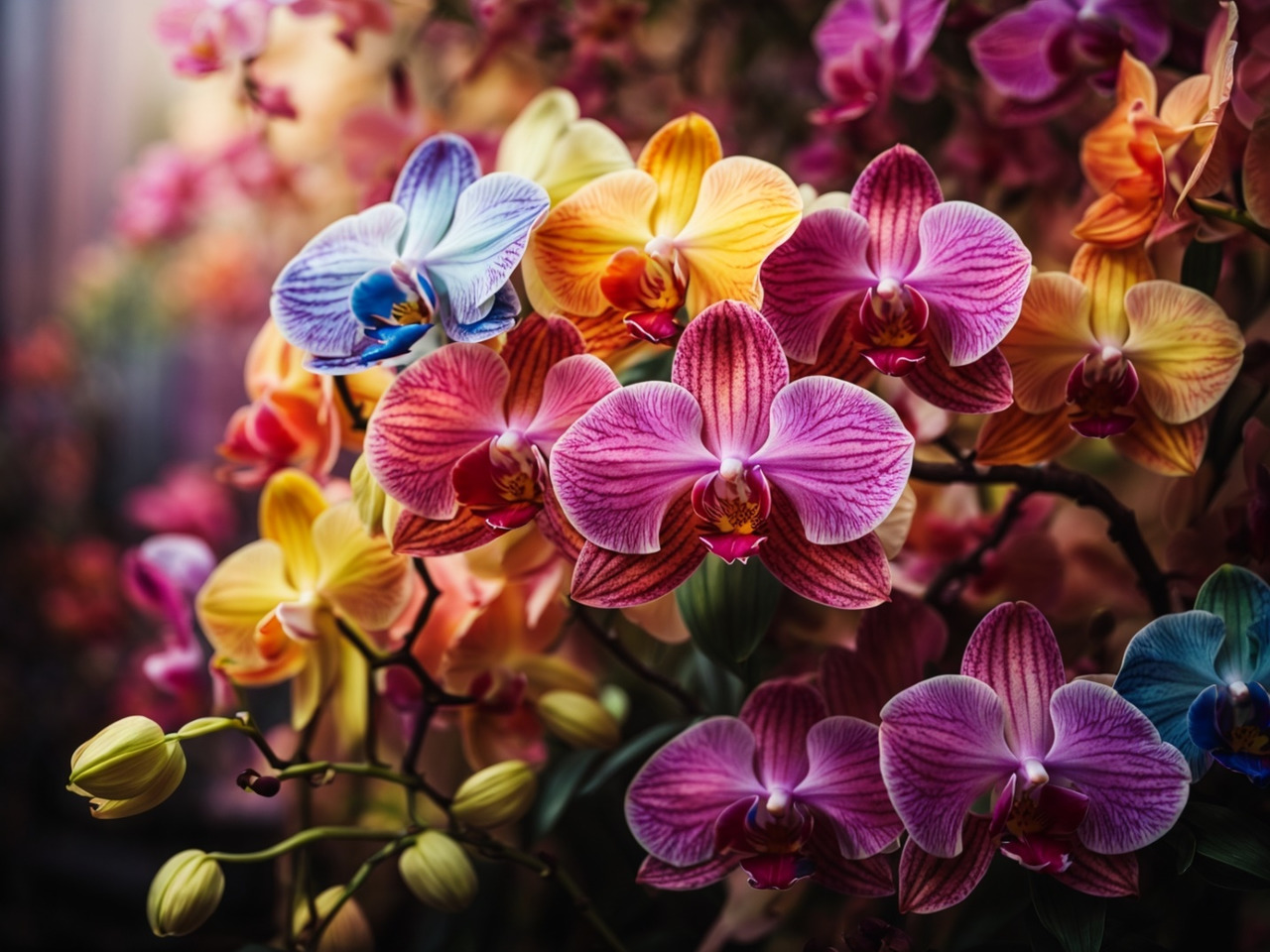
Stretched across the sky was a luminous, shimmering rainbow — its magnificent colors illuminating the horizon. This radiant arch of light beckoned to all, including the spirits of darkness and malevolence that roamed the world. Drawn to the brilliance of the rainbow’s hues, the spirits converged upon it, seeking to claim a place upon its resplendent arc.
However, as the spirits clamored and vied for position, their collective weight proved too burdensome for the delicate rainbow to bear. With a resounding crack, the once-unified arc shattered into a myriad of vibrant fragments — each fragment possessing a unique color and luminosity.
These fragments, imbued with the spirit of the rainbow, descended to Earth to find their place among its rich landscapes. They rooted themselves deep into the fertile soil and blossomed into magnificent orchids, their exotic petals mirroring the hues of the dispersed rainbow.
The people of New Zealand marveled at this extraordinary display — a vivid tapestry of orchids, each one bearing the essence of the fractured rainbow. These radiant flowers captivated the senses with their splendor, becoming symbols of hope, resilience, and the triumph of light over darkness.
Even today, the rainbow orchids that adorn the lands of New Zealand serve as a vivid reminder of the beauty born from chaos. They stand as a testament to the strength of unity, the power of nature’s artistry, and the ever-present magic that resides within the rich tapestry of the land.
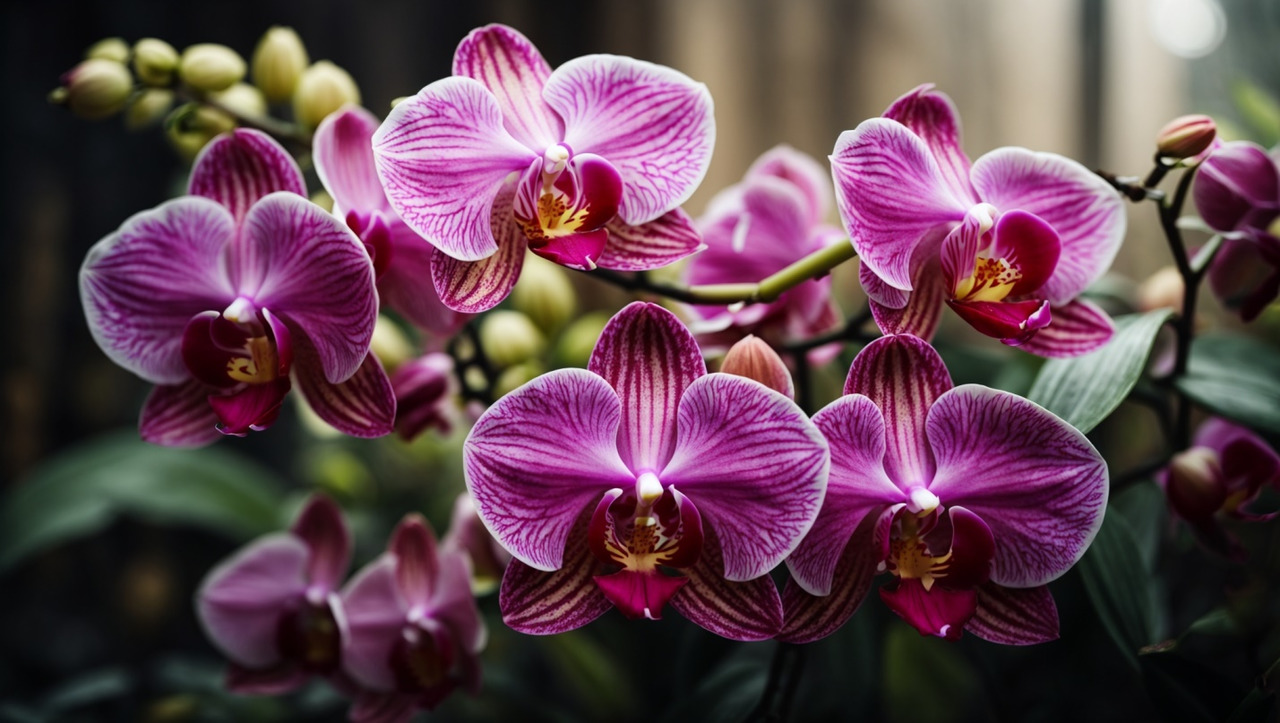
Tulip

Legend of the Tulip’s Origin
In a land far away, where colors painted the landscapes and nature’s wonders flourished, a legend was born. It is said that long ago, a young princess named Tulip lived in a majestic palace surrounded by vast gardens filled with diverse flowers.
Tulip was known for her beauty and grace, and she possessed a gentle spirit that enchanted all who met her. Despite her privileged life, she yearned for adventure and desired to bring joy to the hearts of the people in her kingdom.

One day, while exploring a distant meadow, Tulip stumbled upon a wounded bird. Deeply moved by its suffering, she carefully tended to its injuries and nursed it back to health. In gratitude, the bird shared a secret with the princess — a magical seed that could bring forth a flower of unparalleled beauty.
Undeterred by the risk, Tulip planted the seed in her garden and nurtured it with unwavering care. Days turned into weeks, and weeks into months, until one day, a remarkable transformation occurred. A slender stem emerged from the soil, giving rise to vibrant petals that gradually unfurled, revealing a breathtaking bloom.
The flower that blossomed was like nothing the world had ever seen — a tulip, with its elegant, slender stem and richly colored petals. Its vibrant hues danced in harmony, enchanting the hearts of all who beheld it. News of this captivating flower quickly spread like wildfire throughout the kingdom, and people from far and wide came to witness its splendor.
Thus, the legend of the tulip bloomed, forever intertwined with the kindness and compassion of Princess Tulip. The flower became a symbol of love, beauty, and the transformative power of selflessness. To this day, tulips continue to grace gardens and captivate hearts, reminding us of the magic that can unfold when we nurture and share our gifts with the world.
The Tale of the Fabled Black Tulip
In the heart of a mystic land, where legends breathed life into the soil, a story was told of the rarest of all tulips — the Black Tulip. This fabled bloom cast a spell of fascination over the imaginations of both painters and poets.
It is said that the Black Tulip came into existence through a great act of devotion. In a quaint village nestled within rolling hills, there lived a humble gardener named Alec. Known for his expertise in cultivating flowers of unparalleled beauty, Alec longed for a challenge that would push the boundaries of his skill.
One fateful night, a beguiling dream visited Alec’s sleep. A vision of a tulip, as dark as the midnight sky, with petals as black as the raven’s feathers, filled his mind. Inspired by this strange vision, Alec embarked on a lifelong quest to breed a Black Tulip — a feat believed to be impossible.
Season after season, Alec tirelessly experimented, cross-pollinating different varieties, patiently awaiting the day when his dream would bloom into reality. The villagers, though skeptical, marveled at his dedication and unwavering belief in the impossible. Their whispers of doubt only served to fuel Alec’s determination.

Years passed, and many exquisite tulips emerged from Alec’s garden, but the Black Tulip remained elusive. Undeterred, he continued his quest, undeterred by the passing of time or the naysayers’ voices. Finally, one dawn, as the first rays of sunlight graced his garden, a solitary bud emerged — an otherworldly flower that embodied the essence of the Black Tulip.
Word of this magnificent creation spread like wildfire, drawing crowds from far and wide to witness the legendary bloom. Its dark, velvety petals held a mysterious allure, bewitching all who gazed upon it. The Black Tulip became a symbol of perseverance, unwavering determination, and the rewards that await those who refuse to abandon their dreams.
To this day, the legend of Alec and the Black Tulip endures, inspiring people to delve into the depths of their passions and pursue the impossible. The Black Tulip reminds us that within our hearts lies the power to turn dreams into reality and cultivate beauty even in the darkest of environments.

Sunflower
Бесплатный фрагмент закончился.
Купите книгу, чтобы продолжить чтение.